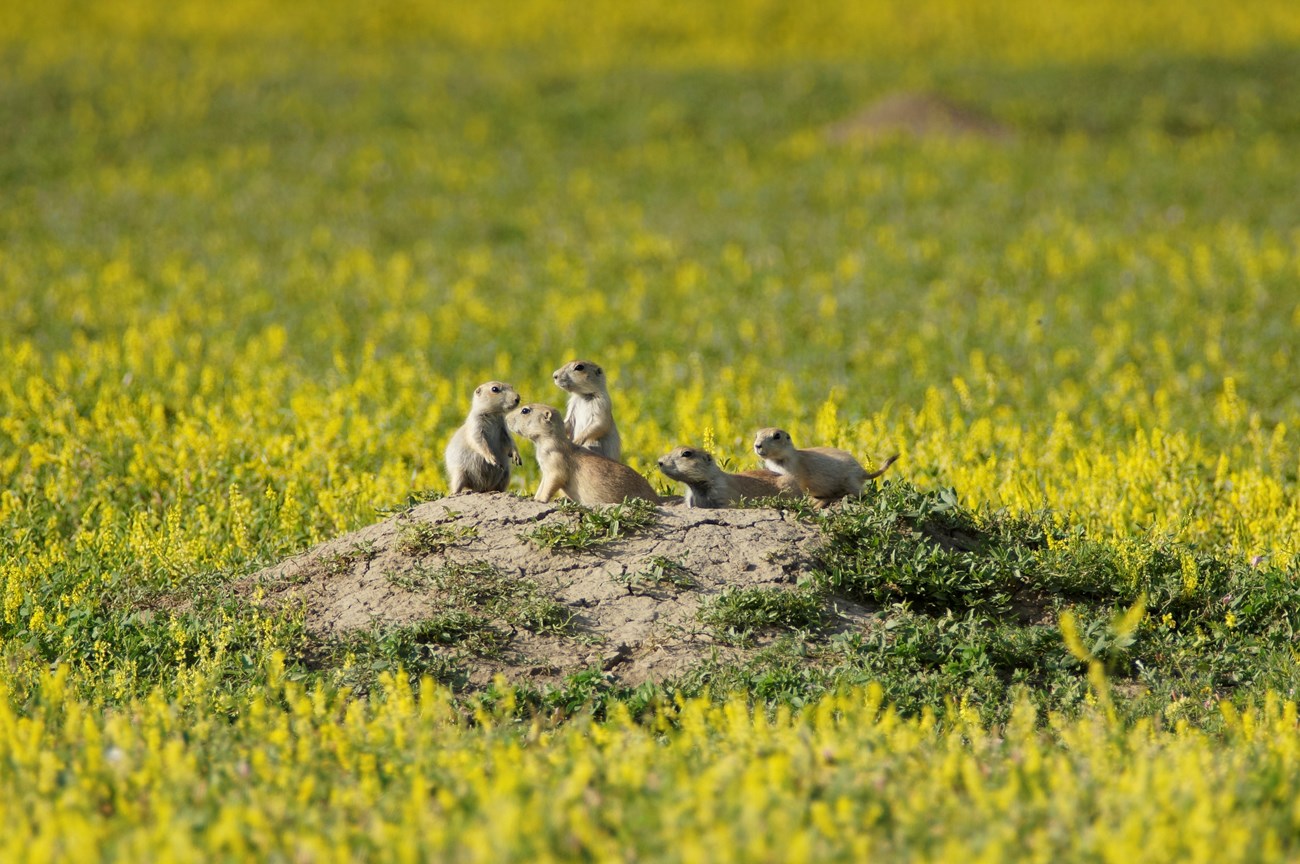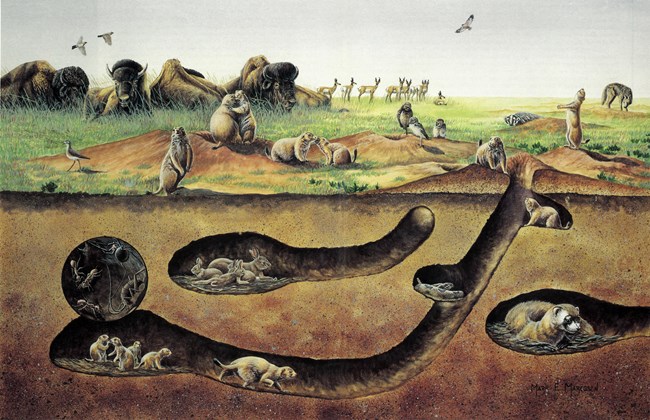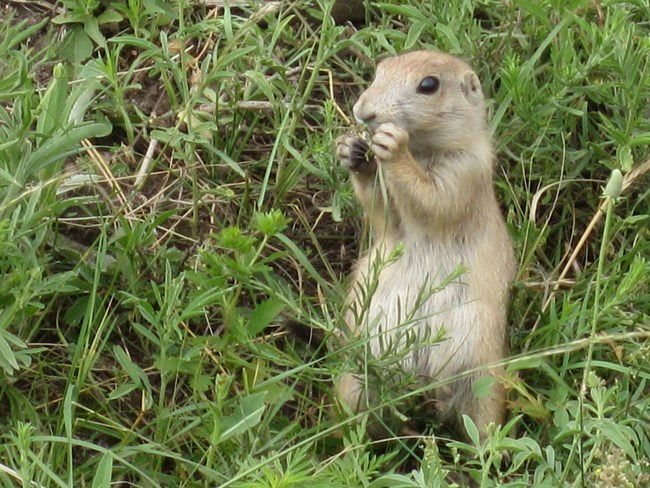Last updated: January 15, 2021
Article
Black-tailed Prairie Dogs

NPS/Jeff Zylland
Prairie dogs are small, short-tailed animals with small ears set far back on their heads. Their light-brown fur blends well with the dirt of their mounds. The Black-tailed prairie dog, Cynomys ludovicianus, is named for their black-tipped tail. They average 12 to 16 inches in length and weigh 1 to 3 pounds. With short, muscular legs and long-nailed toes on their front and hind feet, they are well equipped for a burrowing lifestyle. Although the prairie dog has been known to live for up to eight years in captivity, their average life span in the wild is typically three to four years.

US Fish and Wildlife Service, US Department of the Interior, Chevron
Prairie Dog Colonies and Ecology
Prairie dog colonies, sometimes referred to as "towns", are most recognizable by the mounds and holes at their burrow entrances. A colony will typically have 30 to 50 burrow entrances per acre. Mounds of excavated soil around the burrow entrance are generally cone-shaped and vary from one to three feet in diameter. These mounds serve as lookout points and to prevent water from entering the burrows. Tunnels are generally three to six feet below the surface and about 15 feet long. Burrow systems include several chambers, including one near the surface where the prairie dog can sit and listen for activity above ground. A typical prairie dog town consists of groups that occupy and protect small areas within the town. These groups of prairie dogs are known as coteries. A typical coterie consists of one adult male, three or four adult females, and their young up to one year of age. The residents of each coterie protect their territory from intruders, including prairie dogs from other coteries within the town.The largest prairie dog colony on record was found in Texas. It was 100 miles wide and 250 miles long, and contained an estimated 400 million animals!

NPS/Wind Cave National Park
Predators
Common predators of prairie dogs include coyotes, bobcats, eagles, hawks, foxes, badgers and weasels. The black-footed ferret is one of the rarest animals in North America and depends almost entirely on prairie dogs for food. The ferret has been endangered due to the widespread poisoning of prairie dog towns. Other animals may also be found in prairie dog towns, including, rattlesnakes and burrowing owls, who both use abandoned prairie dog burrows as homes.Praire dogs are susceptible to a number of diseases, the most notable being sylvatic plague. Sylvatic plague is a bacterial disease transmitted by fleas that can affect numerous species of mammals, including humans. However, it is very rare for a person to come down with the plague.
Humans are undoubtedly the most significant mortality factor facing prairie dogs. The conversion of rangeland to cropland, urban development, hunting, and poisoning have all taken their toll on prairie dog populations.
Communication
Black-tailed praire dogs have at least 11 distinct calls and a variety of postures and displays. When a praire dog detects danger, it retreats to a burrow mound and gives a series of short nasal-type yips as a warning. Nearby prairie dogs stop what they are doing, stand on their hind legs, and look for the source of danger. If there is no danger, the prairie dogs will come out and give a "jump-yip" call to reclaim their territory.
NPS/Wind Cave National Park
Food
Prairie dogs feed primarily on plants, selecting forbs (flowering, broad-leaved plants) and grasses high in moisture content and nutritive value to supply their needs for water and energy. In addition to the vegetation it eats, the prairie dog also clips, but does not consume, much vegetation in its colony. This is probably done to keep an unobstructed view of approaching predators. It takes roughly 250 prairie dogs to eat as much grass as a 1,000 pound cow.Breeding
Prairie dogs only give birth to one litter per year. The breeding season is mid-March to mid-April, with the young being born four to five weeks later. The size of the litter varies from two to eight young. During May and early June, the young begin to emerge from their burrows. At this time, yearlings and some adults may relocate, leaving young pups to feel secure both socially and environmentally in the old burrow. When prairie dogs relocate, they take over abandoned holes or dig new holes at the edge of the town.Hibernation
Prairie dogs do not go into true hibernation, but periods of dormancy or "torpor" during the coldest periods of the winter. Their activity and appetite are decreased during winter. They may sleep for many days at a time, but the town is usually active during the milder days of winter.Environment
In many ways, a prairie dog town can be considered a biological oasis. Many wildlife species associate with prairie dogs. Some species feed on prairie dogs, but others utilize the burrow systems of the unique habitat to fulfill their needs. Vacant burrows are used by cottontail rabbits, several species of small rodents, and by burrowing owls. Meadowlarks, grasshopper sparrows, and other birds are found in greater numbers in prairie dog towns than in the surrounding rangeland because they are attracted to the open spaces where seeds and insects are more accessible.Prairie dogs are not always compatible with agricultural interests. By eating and clipping vegetation, the prairie dog does compete with livestock and other grazing animals. the economic impact of prairie dogs on rangeland is difficult to assess and depends on a number of factors, including the density of prairie dogs, the amount of rainfall,the presence of livestock, and the condition of the rangeland.
Prairie dogs and large grazing animals, like bison, can benefit from each other's presence. In areas where there is taller vegetation, domestic livestock keep vegetation cropped low, which allows the prairie dog to occur in areas where it otherwise would not be found. Additionally, the constant trimming of vegetation by prairie dogs contributes to growth that is higher in nutritional quality. This means that grazers like bison, bighorn sheep, and pronghorn all benefit from a prairie dog’s clipping of the grass around its town.
